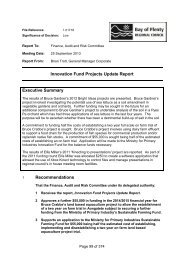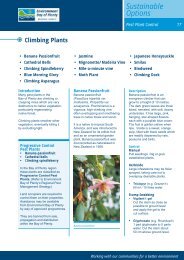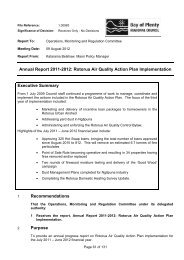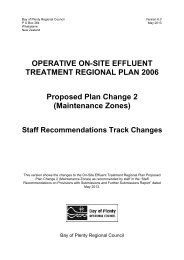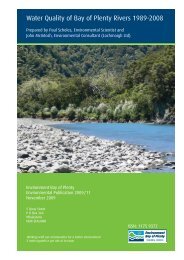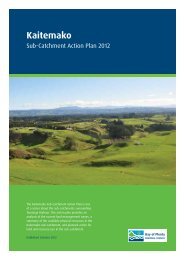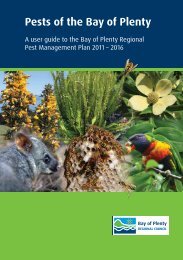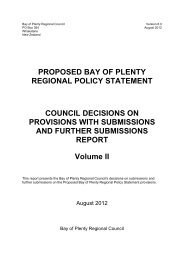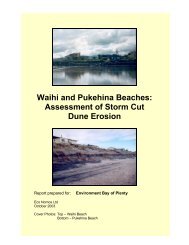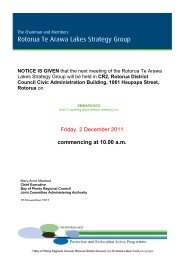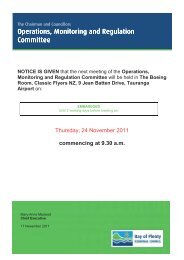Odour Threshold Investigation 2012 - Bay of Plenty Regional Council
Odour Threshold Investigation 2012 - Bay of Plenty Regional Council
Odour Threshold Investigation 2012 - Bay of Plenty Regional Council
Create successful ePaper yourself
Turn your PDF publications into a flip-book with our unique Google optimized e-Paper software.
Rotorua District <strong>Council</strong> also undertakes regular monitoring <strong>of</strong> H 2 S levels within<br />
Rotorua. This monitoring typically has an indoor or enclosed space focus. The<br />
<strong>Council</strong> administers the Geothermal Safety Bylaw 44 and provides an advisory role,<br />
which includes testing for the presence <strong>of</strong> H 2 S gas to ensure as far as possible, the<br />
safety <strong>of</strong> public from geothermal activity. The levels monitored can be as high as<br />
several hundred ppm on occasions 45 .<br />
4.2.2 Kawerau area<br />
Carter Holt Harvey Pulp and Paper Limited at the Tasman Mill continuously monitor<br />
ambient TRS 46 at Edgecumbe 47 (and also historically at Awakaponga 48 ) (see<br />
Figures 4.3 and 4.4 respectively). This monitoring builds on earlier investigative<br />
monitoring undertaken during 1992 which looked at total sulphur levels 49 where a<br />
H 2 S guideline value <strong>of</strong> 7μg/m 3 was exceeded for 4.8 percent <strong>of</strong> the time over the<br />
seven month (mainly winter time) monitoring period. 68<br />
A key issue relating to the Rangitāiki Plains ambient monitoring is that the data<br />
records TRS. These measurements therefore include H 2 S emissions from the<br />
Norske Skog Turbo Alternator 3 electricity generator stack, a number <strong>of</strong> the Carter<br />
Holt Harvey pulp mill stacks, and the geothermal surface features located in the<br />
Kawerau township and the hills to the west. The percentage contribution made by<br />
H 2 S to the TRS readings is unknown, and may vary from hour to hour depending on<br />
both natural and industrial geothermal emissions.<br />
Figure 4.3 Ambient TRS data frequency from Awakaponga site 50 .<br />
44 Rotorua District <strong>Council</strong>, 2008, Geothermal Safety Bylaw, Doc No: IT-621891.<br />
45 Pers. Comms Peter Brownbridge, RDC Geothermal Inspector.<br />
46 Total Reduced Sulphur - includes hydrogen sulphide, mercaptans, dimethyl sulphide, dimethyl<br />
disulphide and other sulphur compounds.<br />
47 Resource Consent 60725<br />
48 Resource Consent 61435<br />
49 Bingham, A.G. et al, 1992, Ambient Air Quality Monitoring – Edgecumbe, 1992. Institute <strong>of</strong><br />
Environmental Health & Forensic Sciences, NECAL Report S92/837C, 5 August 1992, 27p.<br />
50 Resource Consent 65720 Assessment <strong>of</strong> Environmental Effects, Chapter 4.<br />
16 Environmental Publication <strong>2012</strong>/06–A review <strong>of</strong> odour properties <strong>of</strong> H 2 S <strong>Odour</strong> <strong>Threshold</strong> <strong>Investigation</strong> <strong>2012</strong>



